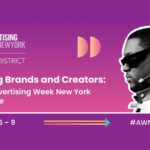Ben Cooper, Creative Strategist at digital agency Organic
There’s a problem when it comes to digital marketing. We talk a lot about integration, data, insights, and yet a lot of digital marketing activity is highly siloed. Social doesn’t seem to talk that much to SEO, and SEO couldn’t care less what the social team is doing. Paid media is off doing its own thing. And the new website that just cost tens (or hundreds) of thousands to design and build? Well, it’s a fiefdom all of its own.
Nowhere is this siloing more apparent than in the seemingly ever-widening gap between digital and brand. How many times have you seen some sort of brand-led content, let’s say an above-the-line ad, and then noticed that what’s going on in that ad isn’t really present on the brand’s social media? And then when you head over to their website, the messages that (presumably) have been carefully crafted are either nowhere to be seen or buried on the landing page you arrived at?
Want a good recent example? Check out BT’s recent ads like ‘Pixellated Paula’ or ‘Love Need Not Wait’ by Saatchi & Saatchi. The creative and even the main messages of the ads don’t appear strongly at all on BT’s main site or their social channels. How much more of a powerful and satisfying an experience it would be if there was a clear and consistent connection between all these touchpoints.
Why is it that digital is so often divorced from brand? In a digital-first world shouldn’t your digital experience be completely cohesive with your brand? I explored this recently in a webinar called For Tech’s Sake: Where Does Brand Sit In Tech Obsessed Digital Marketing and that led to an interesting conversation with Dom Boyd, MD of Insights and Offer at Kantar UK. We talked about the power of brand, why data isn’t necessarily the cure for everything, how optimisation obsession can actually hurt a business, and more.
Why does brand matter?
Ben Cooper, Organic (BC): Dom, I talked about the disconnect between digital and brand in my webinar and why brand should really be at the heart of digital along with the customer. In your experience what do you think is at the root of this issue?
Dom Boyd, Kantar (DB): I’d say that probably most digital marketers don’t really understand brand. That’s not a criticism because I think most people, in general, don’t understand it. In most businesses brand is equated with something like an above-the-line advert. In reality that has always been just a small fraction of what brand is about.
BC: Yes, either it’s ads or if not then it’s just the visible branding elements: colours, logo – brand codes. My experience has been that for most digital projects there is usually some time allocated to trying to understand the users, and even that can be pretty cursory, but almost no attempt to understand the brand beyond the application of its colour palette and so on. So, what is brand about for you?
DB: For me, brand permeates everything in a business, from innovation to organisational culture, including employee behaviour. It sets the direction and trajectory of the business. And that extends absolutely into digital from SEO to an ecommerce experience. That is all brand to me.
Brand is so often a missed opportunity for most businesses because it is a powerful way to align behaviour, but it isn’t seen that way in many businesses. Essentially when it’s applied in the right way brand changes the wiring in a customer’s brain. You build a predisposition in your customers which drives their behaviours through the lens of emotion. If your brand isn’t strong then you don’t get those automatic, strong behaviours which means you have to work much harder to be seen, heard, and considered.
To me, brand is like a turbocharger on the engine of your business. But failing to invest in brand and how it expresses is like leaving the handbrake on: you’re going nowhere fast.
Failure to build and strengthen your brand inhibits growth, and that’s why businesses should be concerned about it. Businesses need to take the handbrake off if they want to grow. Do that and you have a bigger funnel and higher sales, you can command a price premium, and you get better customer retention.
People aren’t data
BC: One of the issues I see is that in digital, because we can measure so much in a very concrete and objective fashion, there’s a real need for people to see the data and this makes people feel safe in making decisions. Whereas the feeling about brand is a lot of it is just intuition at best and fluff at worst.
DB: Yes, brand can be seen as an indulgence or even irrelevant. There is this sort of forensic smallness surrounding data though. What I mean is, you can have a lot of data but that’s not the whole picture, it’s just one part of it. I find it very interesting that Forrester’s work in Customer Experience has shown CX scores flatlining. You essentially have the bulk of brands scoring in the middle, and very few exceptional scores. Why is that? To me, it’s the constant focus on the same lens: pains and gains, needs and wants. But few people seem to be asking: “What is going to differentiate us? What will be powerful and enthralling for customers?” I think what I find particularly concerning about that is that brands are continuing to spend more and more on CX, so why are we seeing less and less spectacular CX scores?
At Kantar we’re all about meaningful difference and it’s this that brands need to be searching for. Why wouldn’t a business want to build competitive differentiation? That’s exactly what the brand creates.
BC: I know people can get lost in it but having lots of data at your fingertips can’t be a bad thing though surely?
DB: No, but there’s a distinct lack of understanding people in digital, from my experience in digital agencies. What happens is data is substituted for real understanding. Data is just data and it’s only a small part of the truth. You get glimpses of understanding real people through things like user testing, and there’s exciting stuff you can do in that space, but my overall feeling is that not enough emphasis is put on really understanding actual people. You do see the same issue in advertising as well. And often when real people are consulted, it’s existing customers.
There’s also a real issue around optimising for the last click. It’s an obsession that seems to make sense at first, but what it leads to is increasing efficiency with decreasing effectiveness. Constantly optimising for a better conversion rate often leads to decisions like cutting marketing budgets because the effectiveness looks great on paper. The problem is that then leads to the funnel not being filled in the first place so you’re optimising on a dwindling customer base and the business isn’t actually growing. I’ve seen it happen a lot.
BC: Yes, I’ve experienced that plenty of times, a real desire to focus right on the bottom of the funnel and shy away from any awareness-building activity. On the user testing point, I think existing customers are easier to get hold of and to get to agree to test, but the pitfall is of course they’re already somewhat familiar with your brand and products/services, so they behave in a different way to entirely new customers.
DB: Of course, because they have expectations already and they can be blind to some of the problems surrounding your brand. It’s important to remember as well that people who are coming in cold to your brand, are your penetration drivers which is where you get real growth. And you don’t need huge numbers to pull together a hypothesis and get a prototype up so you can gather some more data and generate further insights. Putting more of the budget into that would make much more sense, but I’m always surprised when I see how little of quite substantial budgets will go into proper user understanding and testing.
BC: For me, it’s really important to understand the user in digital, but you have to also understand how the brand plays into the customer. If you create a digital experience that is solely about the utilitarian needs, pains, and gains you can end up building a site or app that doesn’t really connect the brand and the customer because you’ve only thought about it from one side.
DB: Yes, and of course for many brands now their website or app is going to be absolutely central to the brand experience. What’s exciting for me is that with digital technology becoming so much more expressive now we should be able to bring more emotion into the digital experience. We know that emotion is a huge driver in how people purchase, whether they are aware of it or not, and it feels like now digital can be less about utility, the plumbing as one of my old bosses used to call it, and more about a meaningful experience.
But unless you know what emotional outcomes you want to create in customers, alongside those more practical “next steps” in their journey to purchase, then you won’t achieve what you want.
Brands need to be thinking about how they want people to feel through their digital journey, what behaviours they are trying to drive, how are the brand purpose and values present in every interaction.
At Kantar we’re exploring the “feeling of rightness”, where you take the pressure out of decision making by ensuring that the brand impression and the surrounding context of the interaction are in such synchronicity that this feeling of rightness is triggered in the moment. It’s about creating optimum efficiency from each interaction.
Bringing brand into digital
BC: I’ve noticed a recent shift in digital, led by Google and LinkedIn’s B2B Institute where there is a greater acknowledgment of the power of the brand. Google’s concept of the Messy Middle really gets across how important it is for brands to be thinking about not only how to navigate the middle of the funnel, but to really think about what is going on beyond it and how it all links up.
To me, the brand is essential in the exposure of course and also then when they come out of the messy middle, into that experience where they tip over into conversion and aftercare. If a brand isn’t shaping those experiences, then things can leave the customer feeling deflated. And that experience then feeds back into exposure – customers will share negative feedback and comments, reviews, which can then be points of exposure and content in the messy middle for new customers.
What do you think the future is for brand and digital?
DB: Yes, that work by Google shows that brand needs to be in the mix across the funnel, digital or not, and especially when it comes to customer experience.
In the same way that you have that same connection between a business strategy, a brand strategy, a marketing strategy, a comms strategy, and finally a creative brief to create an above-the-line ad or some other creative. It’s that cohesion that needs to be present between brand and digital.
Now that digital is such a central brand touchpoint for so many businesses it’s essential to think about how the brand and its values and promise are worked out in terms of brand expression, and what that means in terms of experience. From there, brands can start to think about how that informs really granular aspects of UX and CX on their site and digital platforms, right down to what a button interaction is like. How does the brand manifest in the digital palette? That’s the vital question to answer.








